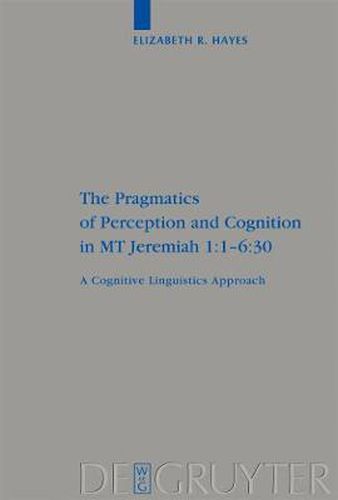Readings Newsletter
Become a Readings Member to make your shopping experience even easier.
Sign in or sign up for free!
You’re not far away from qualifying for FREE standard shipping within Australia
You’ve qualified for FREE standard shipping within Australia
The cart is loading…






This title is printed to order. This book may have been self-published. If so, we cannot guarantee the quality of the content. In the main most books will have gone through the editing process however some may not. We therefore suggest that you be aware of this before ordering this book. If in doubt check either the author or publisher’s details as we are unable to accept any returns unless they are faulty. Please contact us if you have any questions.
Recent advances in cognitive linguistics provide new avenues for reading and interpreting Biblical Hebrew prophetic text. This volume utilises a multi-layered cognitive linguistics approach to explore Jeremiah 1:1-6:30, incorporating insights from cognitive grammar, cognitive science and conceptual blending theory. While the modern reader is separated from the originators of these texts by time, space and culture, this analysis rests on the theory that both the originators and the modern reader share common features of embodied experience. This opens the way for utilising cognitive models, conceptual metaphor and mental spaces theory when reading and interpreting ancient texts. This volume provides an introduction to cognitive theory and method. Initially, short examples from Jeremiah 1:1-6:30 are used to introduce the theory and method. This is followed by a detailed comparison of traditional and cognitive approaches to Biblical Hebrew grammar. These insights are then applied to further examples taken from Jeremiah 1:1-6:30 in order to test and refine the approach. These findings show that Jeremiah 1:1-1:3 establishes perspective for the text as a whole and that subsequent shifts in perspective may be tracked using aspects of mental spaces theory. Much of the textual content yields to concepts derived from conceptual metaphor studies and from conceptual blending theory, which are introduced and explained using examples taken from Jeremiah 1:1-6:30.
The entire analysis demonstrates some of the strengths and weaknesses of using recent cognitive theories and methods for analysing and interpreting ancient texts. While such theories and methods do not obviate the need for traditional interpretive methods, they do provide a more nuanced understanding of the ancient text.
$9.00 standard shipping within Australia
FREE standard shipping within Australia for orders over $100.00
Express & International shipping calculated at checkout
This title is printed to order. This book may have been self-published. If so, we cannot guarantee the quality of the content. In the main most books will have gone through the editing process however some may not. We therefore suggest that you be aware of this before ordering this book. If in doubt check either the author or publisher’s details as we are unable to accept any returns unless they are faulty. Please contact us if you have any questions.
Recent advances in cognitive linguistics provide new avenues for reading and interpreting Biblical Hebrew prophetic text. This volume utilises a multi-layered cognitive linguistics approach to explore Jeremiah 1:1-6:30, incorporating insights from cognitive grammar, cognitive science and conceptual blending theory. While the modern reader is separated from the originators of these texts by time, space and culture, this analysis rests on the theory that both the originators and the modern reader share common features of embodied experience. This opens the way for utilising cognitive models, conceptual metaphor and mental spaces theory when reading and interpreting ancient texts. This volume provides an introduction to cognitive theory and method. Initially, short examples from Jeremiah 1:1-6:30 are used to introduce the theory and method. This is followed by a detailed comparison of traditional and cognitive approaches to Biblical Hebrew grammar. These insights are then applied to further examples taken from Jeremiah 1:1-6:30 in order to test and refine the approach. These findings show that Jeremiah 1:1-1:3 establishes perspective for the text as a whole and that subsequent shifts in perspective may be tracked using aspects of mental spaces theory. Much of the textual content yields to concepts derived from conceptual metaphor studies and from conceptual blending theory, which are introduced and explained using examples taken from Jeremiah 1:1-6:30.
The entire analysis demonstrates some of the strengths and weaknesses of using recent cognitive theories and methods for analysing and interpreting ancient texts. While such theories and methods do not obviate the need for traditional interpretive methods, they do provide a more nuanced understanding of the ancient text.